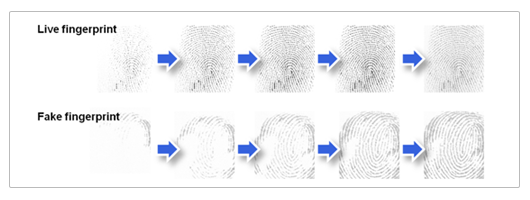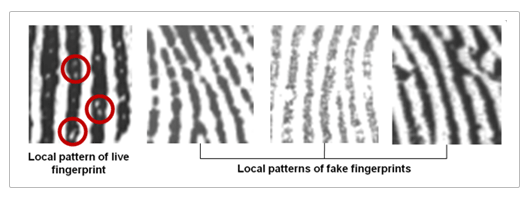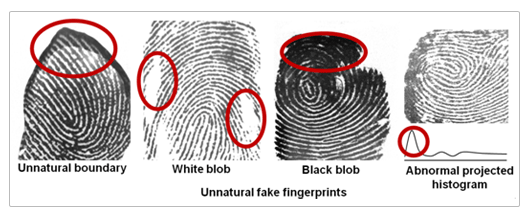Table of Contents
Suprema’s Live Finger Detection Technology

Technology related to physical security systems has made great leap forward, however traditional authentication methods such as locks and keys, PIN, cards are still widely used. This leads to potential risks of credential breach where credentials are passed to others, lost or stolen that ultimately leads to compromise in security. Biometric authentication can easily resolve such problems, drastically enhancing security and credibility of personal authentication by forcing the use of true identity and prevent people from authenticating oneself using someone else’s credentials.
The advantages provided by biometric technology allowed quick adoption by the security markets. Among the biometric technologies, fingerprint technology offered most flexibility with cost benefits that allowed its adoption to various applications. Today, fingerprint is the most flexible and reliable method with higher recognition rate than any biometric technologies such as iris, facial, and vein recognitions.
However, there’s also a growing concern with regards to the usage of fake fingerprints. Since fingerprint residue can be easily captured from things that we touch in our daily lives, if we do not pay enough attention, somebody can capture and replicate your fingerprints and use them for malicious purposes.
Big Enemy; Fake Fingerprint and Spoofing
The replicated fingerprint made from materials like clay, gelatin, silicone and rubber is called ‘fake fingerprint’ and authenticating with these fake fingerprints is called ‘spoofing’. After the release of the iPhone 5S and introduction of a built-in fingerprint sensor, contests were held to crack the device’s fingerprint scanner have been held with lots of hackers joining the competitions and numerous IT magazines reported about the vulnerability of the fingerprint sensor against fake fingerprints. Numerous videos have been recently uploaded on YouTube where hackers breached the security by making fake fingerprints from Play-Doh, gelatin, silicone, rubber and the like and explained how to make the fake fingerprints.
What is the solution?
Suprema’s Live Finger Detection (LFD) technology is based on analysis of dynamic and static image characteristics of the fake fingers, and how they can be distinguished from those of live fingers. With the advanced analysis algorithm to detect abnormalities in dynamic changing pattern of fingerprints images, and several static features of liveness or unnaturalness of fingers, fake fingers are clearly distinguished from live fingers.
Dynamic changing pattern analysis
As fingers gradually make contact with the sensor surface, live fingers naturally demonstrate changes in patterns of area, intensity, and movement, but fake fingers produce unnatural changing patterns of separated areas, partially dark area, distorted boundary shape, and large movement of core part. By detecting these abnormalities in dynamic changing patterns from continuous analysis of fingerprint images, fake fingers are distinguished from live fingers. Specifically, this method is very effective in rejecting fake fingers made from hard materials such as paper, film, clay, and hard rubber.

Liveness feature analysis
In fingerprint images, there are several localized features which reveal the liveness of fingers: pore distribution, ridge sharpness, regularity of ridge-valley boundary among others. These localized liveness features are normally too small and elaborate to be copied by simple and soft faking materials such as silicon, rubber, and gelatin. Since Suprema’s high performance imaging sensor can capture high quality fingerprint images, and various local liveness features are can easily be distinguished by our advanced analysis algorithm.

Unnaturalness feature analysis
Usually, it is very hard to make a perfect fake finger and almost every fake fingers cannot avoid revealing their unnaturalness - unnatural sharp boundaries, too many white blobs or too large black blobs within fingerprint area, abnormal peaks in histogram distribution, and so on. By observing the mixture of numerous unnaturalness features, numerous fake fingers are effectively rejected.

New Live Finger Detection technology and Liveness Decision Engine
Suprema’s newly developed Liveness Decision Engine (LDE) can effectively prevent spoofing. It detects fake fingerprints with a technology called Dual Light Source Imaging which utilizes infra-red rays and a white light.

The LDE can block fake fingerprints made from paper, film, glue, rubber, clay and silicon all together by comparing images obtained with white lights and infrared rays.
The new OP5 sensor applied to Suprema’s recently released fingerprint readers has reduced distortion and improved contrast uniformity, and features Adaptive Gain Control algorithm and a proximity sensor, which enables the sensor to detect fake fingerprints made from paper, film, glue, rubber, clay and silicon all together.
| Fake Finger | Material & Characteristic | Device A | Device B | BioStation A2 |
|---|---|---|---|---|
 | Paper inversely printed | O | O | O |
 | Film inversely printed | O | O | O |
 | Glue | O | O | O |
 | Rubber | O | O | O |
 | Clay | X | O | O |
| | Silicone (Transparent) | X | X | O |
| | Silicone (Opaque) | X | X | O |